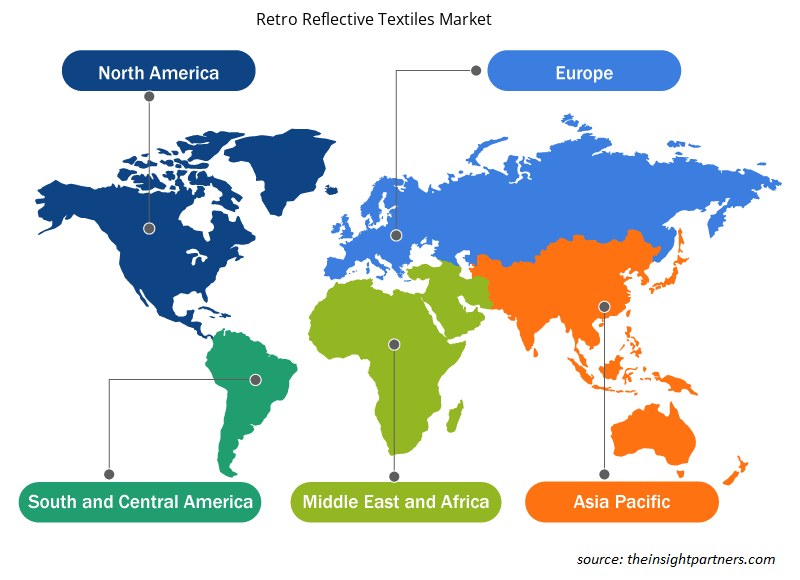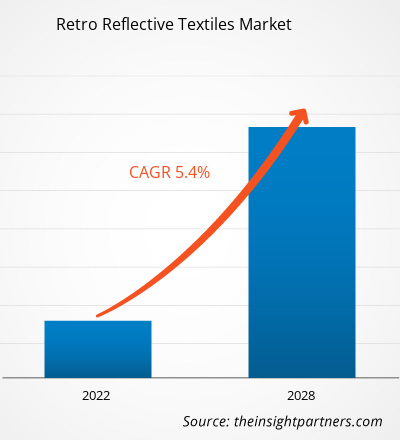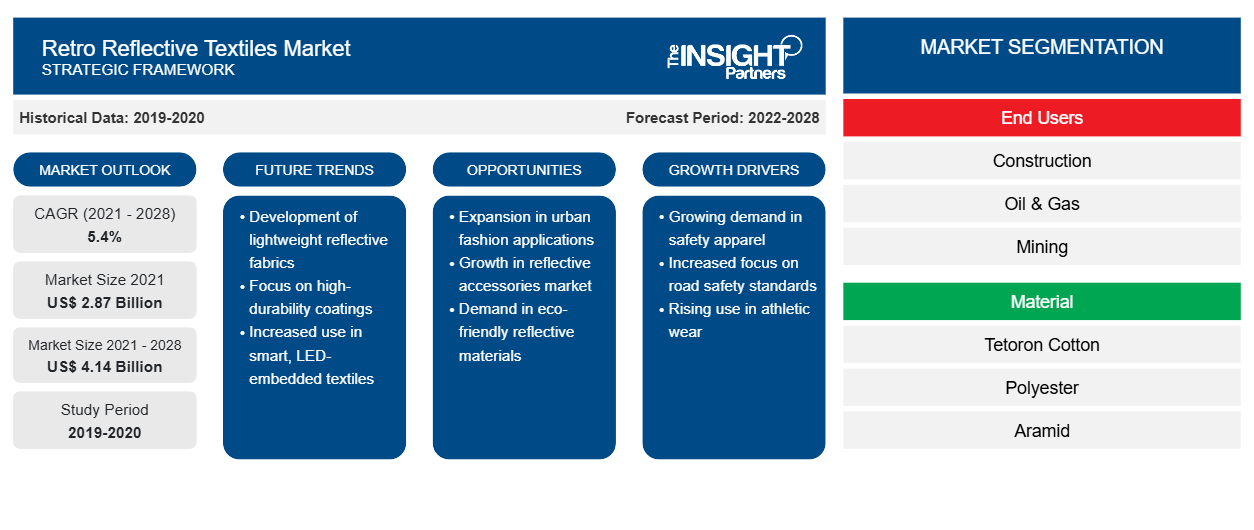[研究报告] 逆反射纺织品市场预计将从 2021 年的 28.728 亿美元增长到 2028 年的 41.398 亿美元;预计2021 年至 2028 年的复合年增长率为 5.4%。
反光布由能将光反射回光源的小玻璃珠制成。它被广泛用于建筑和运输等行业的防护服中。由于各国政府制定的安全法规,对反光纺织品的需求有所增加。此外,采矿业等终端用户行业事故数量的增加推动了对反光纺织品的需求。2020
年,亚太地区占据全球市场的最大份额;预计在预测期内将实现最高的复合年增长率。印度、中国和日本是主要的市场股东。汽车、交通运输、建筑和基础设施等行业的高增长对亚太地区 反光纺织品市场产生了重大影响。亚太地区的建筑和基础设施行业正在增长。
定制此报告以满足您的需求
您可以免费定制任何报告,包括本报告的部分内容、国家级分析、Excel 数据包,以及为初创企业和大学提供优惠和折扣
-
获取此报告的关键市场趋势。这个免费样品将包括数据分析,从市场趋势到估计和预测。
COVID-19 疫情对反光纺织品市场的影响
2021 年,各经济体开始复苏,对全球市场产生了积极影响。预计不同应用领域对反光纺织品的需求也将大幅增加,例如制造安全服装。此外,制造商可以满负荷运转以弥补供需缺口。此外,各国许多公民都已完全接种疫苗,各国政府正在对建筑、基础设施和制造业进行投资。预计各种终端使用行业的增长将导致预测期内对反光纺织品的需求旺盛。
市场洞察
劳动力安全措施和高能见度安全服装 ( HVSA )的重要性日益增加
在工作场所,如建筑工地的道路、石油和天然气工业、化学工业和采矿场,事故和死亡事件越来越常见,因为能见度低是一个问题。工业区经常使用起重机等重型机械。缺乏防护设备的工人更容易发生事故、受伤和死亡,因为这些重型机械的操作员不容易发现他们。此外,数百万工人在交通和建筑设备附近工作时容易发生撞击、碾压和倒车事故。工作场所安全的重要性日益增加,预计将在预测期内推动反光纺织品市场的增长。
最终用户洞察
根据最终用户,全球市场细分为建筑、石油和天然气、采矿、运输、消防员、执法机构等。2020 年,建筑部门占据了最大的收入份额;预计在预测期内将以最高的复合年增长率增长。随着城市化的快速发展,建筑工地也在不断扩大,这导致了许多以城市热岛为代表的热环境问题。这些反射器用于建筑工地的招牌、人员服装和车辆。逆反射纺织品被认为是一种创新解决方案,可以减少制冷所需的能量并改善城市小气候。逆反射纺织材料可提高可见度,是必不可少的配件材料。此外,建筑和基础设施活动的快速增加导致招牌和道路彩色标记的使用增加,从而推动了市场的增长。逆反射纺织品市场的主要驱动力是对建筑和基础设施领域的大规模投资。
3M;道明光学化工有限公司;杭州华星反光材料有限公司;黄山 星威 反光材料有限公司;PS ENTERPRISES;Swicofil AG;Unitika Sparklite Ltd. ; YGM Reflective;HJ Corp;和HIGHVIZ是反光纺织品市场的参与者。这些公司为市场提供了广泛的产品组合。这些公司在发展中地区的存在为反光纺织品市场提供了丰厚的机会。市场参与者正在开发高质量和创新的产品以满足客户的要求。
反光纺织品市场区域洞察
Insight Partners 的分析师已详尽解释了预测期内影响反光纺织品市场的区域趋势和因素。本节还讨论了北美、欧洲、亚太地区、中东和非洲以及南美和中美洲的反光纺织品市场细分和地理位置。

- 获取反光纺织品市场的区域特定数据
反光纺织品市场报告范围
| 报告属性 | 细节 |
|---|---|
| 2021 年市场规模 | 28.7 亿美元 |
| 2028 年市场规模 | 41.4亿美元 |
| 全球复合年增长率(2021 - 2028) | 5.4% |
| 史料 | 2019-2020 |
| 预测期 | 2022-2028 |
| 涵盖的领域 |
按最终用户
|
| 覆盖地区和国家 |
北美
|
| 市场领导者和主要公司简介 |
|
反光纺织品市场参与者密度:了解其对业务动态的影响
反光纺织品市场正在快速增长,这得益于终端用户需求的不断增长,而这些需求又源于消费者偏好的不断变化、技术进步以及对产品优势的认识不断提高等因素。随着需求的增加,企业正在扩大其产品范围,进行创新以满足消费者的需求,并利用新兴趋势,从而进一步推动市场增长。
市场参与者密度是指在特定市场或行业内运营的企业或公司的分布情况。它表明在给定市场空间中,相对于其规模或总市场价值,有多少竞争对手(市场参与者)存在。
在反光纺织品市场运营的主要公司有:
- 3M
- 道明光学化工有限公司
- 杭州华星反光材料有限公司
- 黄山市兴伟反光材料有限公司
- 普罗莫斯蒂
免责声明:上面列出的公司没有按照任何特定顺序排列。

- 了解反光纺织品市场的主要参与者概况
报告亮点
- 市场上不断发展的行业趋势,帮助参与者制定有效的长期战略
- 发达市场和发展中市场采用的业务增长战略
- 2019 年至 2028 年反光纺织品市场定量分析
- 全球反光纺织品需求量预测
- 波特的五力分析说明了行业中买家和供应商的效力
- 了解竞争市场状况的最新发展
- 市场趋势和前景以及推动和制约反光纺织品市场增长的因素
- 通过强调支撑商业利益的市场策略来协助决策过程,从而促进市场增长
- 不同节点的市场规模
- 市场详细概述和细分,以及反光纺织品行业动态
- 各地区反光纺织品市场规模及增长潜力巨大
“2028 年全球反光纺织品市场分析”是一项针对化学品和材料行业的专业深入研究,特别关注全球反光纺织品市场。该报告旨在通过详细的市场细分提供市场概述。反光纺织品市场根据最终用户、材料和地理位置进行细分。根据最终用户,反光纺织品市场细分为建筑、石油和天然气、采矿、运输、消防员、执法机构等。根据材料,市场细分为特多龙棉、涤纶、芳纶等。按地理位置划分,反光纺织品市场大致分为北美、欧洲、亚太地区 (APAC)、中东和非洲 (MEA) 以及南美洲和中美洲。
公司简介
- 3M
- 道明光学化工有限公司
- 杭州华星反光材料有限公司
- 黄山市兴伟反光材料有限公司
- PS 企业
- 瑞士斯威科菲尔公司
- 尤尼吉可 Sparklite 有限公司
- YGM 反光
- HJ 公司
- 高维兹
- 历史分析(2 年)、基准年、预测(7 年)及复合年增长率
- PEST和SWOT分析
- 市场规模、价值/数量 - 全球、区域、国家
- 行业和竞争格局
- Excel 数据集
近期报告
客户评价
购买理由
- 明智的决策
- 了解市场动态
- 竞争分析
- 客户洞察
- 市场预测
- 风险规避
- 战略规划
- 投资论证
- 识别新兴市场
- 优化营销策略
- 提升运营效率
- 顺应监管趋势























 获取免费样品 - 逆反射纺织品市场
获取免费样品 - 逆反射纺织品市场